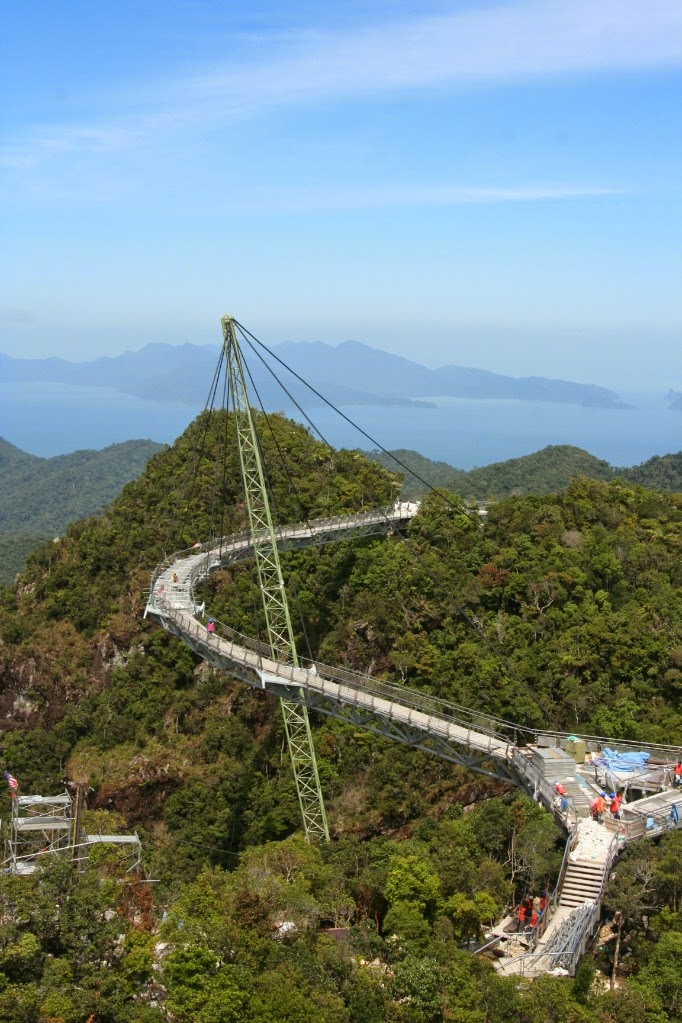One of the main attractions of Langkawi is the cable car that runs 750m up to the second highest peak on the island, Gunung Matcincang.
 |
| SkyCab! |
Branded as the 'SkyCab', this makes the most of what Langkawi has to offer, which is unparalleled views over the surrounding tree-covered islands and out to the Andaman Sea.
 |
| Oriental Village |
A rather unnecessary and bizarre theme park town, called Oriental Village, has sprung up at the base of the cable car. The accompanying cross-selling attempts to supersize the already naturally awesome (lit.) sight with other attractions including a 5-minute 'cine 180' experience in which our inner ears are tantalised by vertigo-inducing images of upside-down rollercoasters streaming through our optical nerves.
 |
| SkyBridge |
To complete the Disneyland feel, there is a genuine if, I suspect, not wholly endorsed walking Minnie Mouse with which we were encouraged to have our picture taken. At another stage of the ascent, we were photographed in front a green screen, over which the actual view behind the screen was composited and presented to us to purchase. I presume this is to guard against the elements, which may conspire to ruin a natural photograph. Still, it seemed a little superfluous on the cloudless day when no amount of Photoshop magic could rival the actual view.
 |
| Langkawi islands viewed from Ginung Matcingcang |
Gunung Matcincang is named after a legend about two giants, Matcincang and Matraya, who fought and were turned into the two tallest mountains on Langkawi. With the peaks forming a clear face, it is easy to see how this legend originated.
 |
| The face of Mat Cincang |
From the foot of the mountain, it was a short walk to Telaga Tujuh, the Seven Wells waterfall, so named for the seven pools that have formed there.
 |
| Seven Wells waterfall |
So attractive is the environment there that it is said that fairies used it as their bathing place. For this reason, the water us believed to have healing properties. I cannot ratify either of these claims, but a dip in the cool waters and a rinse under the waterfall was most welcome after the hot walk.
A climb of 638 steps to the top of the waterfall rewarded us with an area where the fairies must have had some fun splashing about.
 |
| Rock slide |
A natural path worn smooth along the surface of the rocks provides a perfect slide into a deep pool of water. Luckily the water was flowing after a few recent spells of rain and we happily tobogganed along the rocks like big children. Oddly no actual children were there.
At home, I took the opportunity to cook dinner. Although we have access to a kitchen, a combination of remote markets, good local restaurants, and our host's enthusiasm for cooking and eating out, means I haven't been behind the stove for a while.
 |
| Mee kari (kind of) |
I attempted a version of mee kari, curry noodles, using egg noodles and a yellow curry of aubergine, fried tempeh, shallots, garlic, lemongrass, and coconut milk. I adore aubergine cooked slowly until it melts in my mouth. Tempeh is a local product to Indonesia and Malaysia, made with whole soya beans that have been inoculated with a bacteria that causes a mould to grow and turn the loose beans into a cake or brick. The concept sounds disgusting, but the mould is a good mould, like in blue cheese, and the result, when sliced and fried, is nutty and meaty. Finding it in the UK is expensive, and my attempts to produce it at home have met with mixed success. Tempeh needs a warm environment in which to grow the mould, and so can be produced in the natural heat of SE Asian countries.
No comments:
Post a Comment